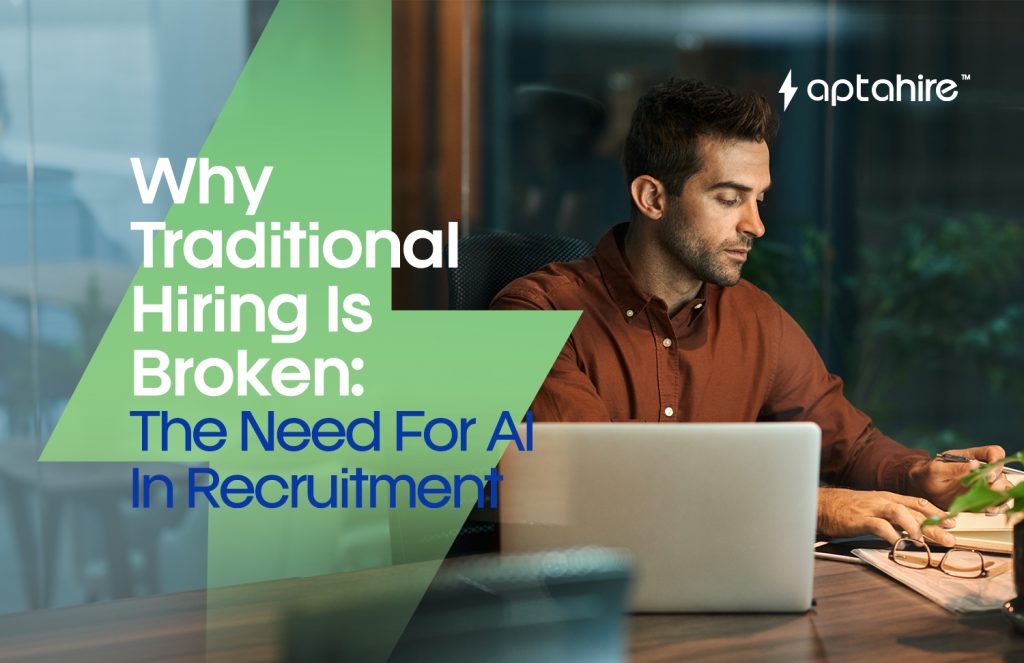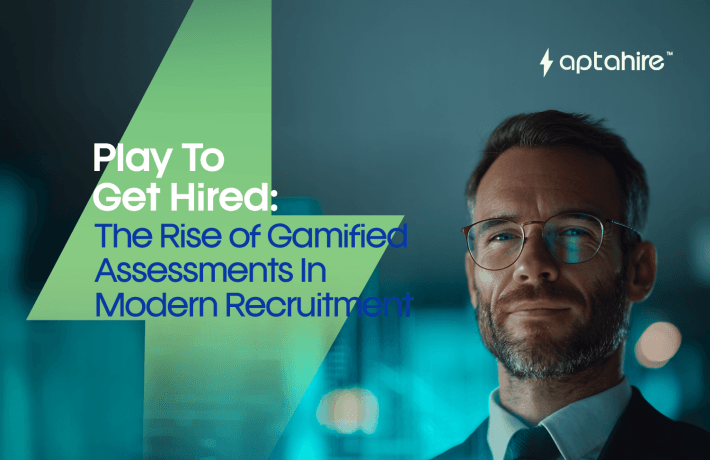Why Traditional Hiring is Broken: The Need for AI in Recruitment

Let’s be real, hiring today feels a bit like fishing in a hurricane. You’re out there, resumes flying everywhere, job boards overflowing, LinkedIn messages pinging non-stop… and yet, the perfect catch still seems to slip through the cracks.
Despite all the noise, traditional hiring practices haven’t evolved much from what they were 20 or even 30 years ago. We’re still relying on resumes that can be gamed, gut instincts that can be biased, and interviews that are more like rehearsed performances than genuine assessments. We waste time, energy, and resources chasing talent, and often end up with mismatches, dropouts, or worse, hires who just don’t fit in.
Here’s a truth most HR teams and hiring managers whisper but rarely say out loud:
Traditional hiring is inefficient, biased, and no longer capable of keeping up with the pace of modern business.
Let’s break it down:
- Recruiters are drowning in resumes. A single job posting can attract hundreds, sometimes thousands of applications. No human can fairly evaluate them all.
- The best candidates are off the market within 10 days. Yet most companies take weeks, sometimes months, to complete a single hiring cycle.
- Biases: conscious and unconscious, seep into every stage, from resume filtering to interview evaluations. That impacts diversity, inclusion, and ultimately, performance.
- Costs are mounting. A bad hire can cost thousands. Missed opportunities due to slow or poor hiring? Even more.
And candidates aren’t happy either. They feel ghosted, frustrated by lack of feedback, and exhausted by repeated interviews that lead nowhere. The hiring experience often feels like a black box, and trust in companies takes a hit.
So, what’s the fix?
Thats where Artificial Intelligence comes into the play Artificial Intelligence.
No, this isn’t about robots replacing recruiters or scary sci-fi scenarios. This is about smart, ethical, AI-powered tools that assist hiring managers in making faster, fairer, and more informed decisions. It’s about automating the boring stuff, resume screening, scheduling, initial assessments, so that humans can focus on what matters: connecting with the right people.
This blog explores why traditional hiring methods are failing us, how AI is transforming recruitment, and what companies need to do today to stay ahead in the war for talent.
Because in the new world of work, recruitment isn’t just about filling roles, it’s about building the future. And AI might just be the compass we need to navigate this evolving landscape.
The Problem with Traditional Hiring
1. Resumes Lie (or Hide Too Much)
Let’s face it: resumes are the ultimate highlight reels. Candidates often exaggerate or tailor their achievements to look perfect on paper, but there’s little clarity on authenticity, soft skills, or even relevance.
A 2022 Checkster study revealed that 78% of candidates lie or stretch the truth on their resumes.
And if hiring managers are spending an average of 7 seconds scanning each resume (as per an Eye-Tracking study by Ladders), what’s really being evaluated? Not potential. Not personality. Just keywords and formatting.
2. Human Biases Are Unavoidable
Even with the best intentions, unconscious biases creep in. Names, accents, educational institutions, or even profile pictures influence decisions, often unconsciously.
According to Harvard Business Review, ethnic minorities with “non-white” sounding names are 50% less likely to receive callbacks.
Traditional hiring methods often fail to ensure a fair, unbiased selection process, meaning talented individuals are overlooked, and diversity goals remain unfulfilled.
3. Too Slow for Today’s Talent Market
Traditional hiring processes can drag on for weeks, if not months. Meanwhile, top candidates aren’t waiting around. They’re being snapped up by more agile competitors who move faster.
Glassdoor reports that the average interview process in the U.S. lasts 23.8 days, depending on industry and role.
In the digital economy, this delay equals opportunity loss.
4. Gut Feelings Aren’t Data
Hiring managers often say, “I just had a good feeling about them.” But “gut instinct” isn’t a recruitment strategy, it’s a gamble.
And guess what? It often fails.
The U.S. Department of Labor estimates that a bad hire can cost a company up to 30% of that employee’s first-year earnings.
So why do we continue to bet businesses on feelings?
Enter AI: The Game-Changer in Recruitment
AI doesn’t replace recruiters, it amplifies their power. By automating repetitive tasks, removing bias, and using real-time data, AI streamlines hiring and improves quality.
Let’s break this down.
1. AI-Powered Resume Screening
Rather than relying on manual resume review, AI models like natural language processing (NLP) can instantly parse thousands of resumes and match them against job descriptions, without bias or fatigue.
Case Study: Unilever
Unilever uses AI to screen over 250,000 applications annually. They deploy AI chatbots and gamified assessments, followed by video interviews analyzed by AI. Result?
- 90% reduction in hiring time
- 100% increase in candidate diversity
- Millions saved in recruitment costs
Their AI system looks beyond keywords, analyzing speech patterns, eye movements, and facial cues to assess emotional intelligence and leadership potential.
2. Bias-Free Shortlisting
AI can be trained to ignore gender, ethnicity, or age-related data points, focusing purely on skills, aptitude, and role-fit.
A McKinsey study shows that diverse companies are 35% more likely to outperform their peers. AI can be a key tool in building such teams.
Platforms like Aptahire use AI to score candidates on performance, not perceptions, removing the noise and leveling the playing field.
3. Video Interview Analysis
AI can analyze video interviews using computer vision and sentiment analysis. It doesn’t just look at what’s said, but how it’s said.
- Is the candidate confident?
- Are they genuine?
- Do their expressions match their responses?
Eye-tracking, micro-expressions, and tone analysis are already being used by companies like HireVue, giving recruiters data-rich candidate reports that go beyond “vibe.”
4. Predictive Analytics for Better Hiring
AI models can use historical hiring data to predict:
- Which candidates will stay longer
- Who will perform better
- What skill gaps may emerge in the future
This future-facing approach ensures long-term hires, not just quick fills.
IBM uses predictive hiring tools that have reduced turnover by 20% by identifying red flags early in the recruitment process.
AI in Recruitment: By the Numbers
Here are some compelling stats that underscore AI’s impact:
| Metric | Stat |
| Time saved on screening | Up to 75% |
| Cost-per-hire reduction | 30-40% |
| Increase in quality-of-hire | 25-50% |
| Bias reduction in shortlisting | 30% or more |
| Hiring accuracy improvement | 2–3x more predictive than resume screening |
The Common Concerns About AI in Hiring
Like any technology, AI comes with its challenges.
1. Bias in Algorithms
If trained on biased data, AI can reinforce existing inequalities. The fix? Continuous training, human oversight, and transparent models.
2. Loss of Human Touch
Recruitment isn’t just about skill match, it’s about culture fit. But AI isn’t here to replace conversations; it simply helps narrow the funnel so humans can focus on what they do best: connect.
3. Privacy Concerns
AI models analyze personal behavior. It’s essential to maintain transparency, candidate consent, and GDPR compliance during data collection.
The Hybrid Hiring Model: AI + Human = Gold Standard
The best approach? Use AI for what machines do best (speed, accuracy, scale) and use humans for what we do best (empathy, intuition, culture assessment).
Imagine this workflow:
- AI scans resumes and ranks candidates
- AI conducts video screening and scores behavioral cues
- Recruiter steps in for the top 10%, armed with data and insights
- Final interviews are efficient, informed, and bias-aware
That’s not just smart. That’s future-ready hiring.
Real-World Success Stories
Vodafone
Vodafone adopted an AI platform to analyze interviews using facial recognition and sentiment tracking. Their results?
- 8x faster screening
- Improved diversity
- Positive candidate feedback due to transparent feedback and faster responses
Amazon (and Its Lesson)
Amazon once tried to build an AI hiring tool, but the model began downgrading resumes with the word “women’s” in them, having trained on 10 years of biased data.
Lesson? Garbage in, garbage out. Even AI needs ethics and clean inputs.
The Future of AI in Recruitment
We’re just getting started. The next-gen AI in hiring will:
- Use Generative AI to tailor personalized job descriptions
- Offer career path recommendations to candidates
- Leverage emotion AI to detect burnout or disengagement
- Use AR/VR simulations for role-based testing (imagine coding inside a virtual environment!)
And platforms like Aptahire are leading this evolution by combining deep-tech, ethical frameworks, and candidate-first design principles.
Final Thoughts: It’s Time to Upgrade
Traditional hiring is like using a Nokia 3310 in the age of iPhones. It might work, but you’re missing out on efficiency, accuracy, and innovation.
AI isn’t a threat to recruiters, it’s their sidekick. It amplifies human judgment with insights and automation. It removes bias, saves time, and builds diverse, high-performing teams.
So the question isn’t “Will AI take over recruitment?”
The real question is:
Are you ready to recruit with intelligence?
FAQs
1. How has AI affected the hiring process?
AI has made hiring faster, more accurate, and less biased by automating resume screening, analyzing interviews, and predicting candidate success.
2. What is the traditional hiring process?
It’s a manual, step-by-step process involving job posting, resume screening, interviews, and reference checks—often slow and subjective.
3. What are the challenges of AI in recruitment?
Key challenges include biased training data, lack of transparency, privacy concerns, and loss of human touch if overused.
4. What is the role of AI in the recruitment process?
AI helps automate screening, rank candidates, analyze interviews, and provide data-driven hiring insights.
5. What is the difference between traditional and modern recruitment?
Traditional is manual and slow; modern uses AI for speed, accuracy, and better candidate experience.
6. What is the traditional interview method?
It’s usually a face-to-face or phone interview, based on subjective Q&As and gut feeling—often prone to bias.



